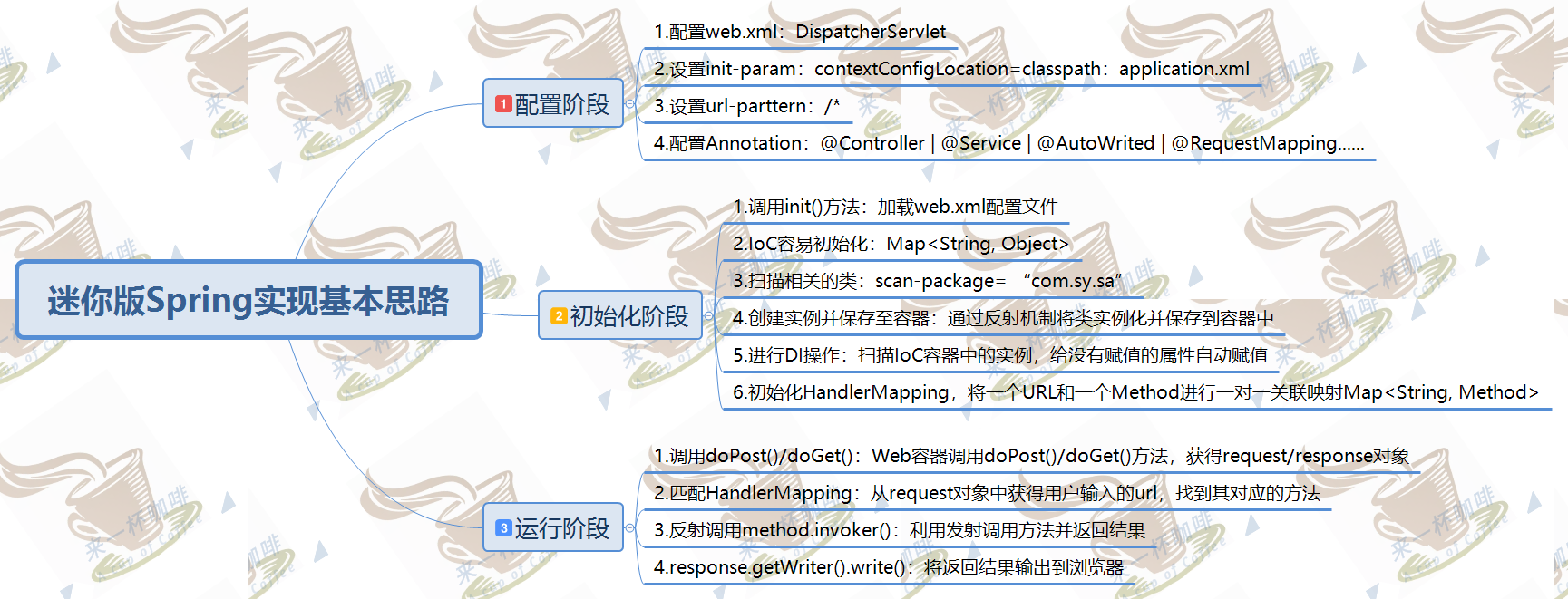看过Spring5源码的同学们,一开始肯定会边看边去用断点进行源码调试,调试来调试去时间长了肯定会晕车的,最有效的方式是先猜测后进行验证,当然猜测是建立在对阅读源码相当有经验的基础上的,否则也是一头雾水。对于使用很长时间Spring框架的开发者来说,应该对其架构和结构不会太陌生,可以大胆地进行猜测。
根据源码猜测,整理了迷你版Spring的基本实现思路,如下图:

一、web.xml配置文件
所有依赖于Web容器的项目,基本都是从web.xml文件开始的,首先我们先配置好web.xml的文件内容,代码如下:
<?xml version="1.0" encoding="UTF-8"?>
<web-app xmlns="http://xmlns.jcp.org/xml/ns/javaee"
xmlns:xsi="http://www.w3.org/2001/XMLSchema-instance"
xsi:schemaLocation="http://xmlns.jcp.org/xml/ns/javaee http://xmlns.jcp.org/xml/ns/javaee/web-app_4_0.xsd"
version="4.0">
<display-name>mini-spring</display-name>
<servlet>
<servlet-name>symvc</servlet-name>
<servlet-class>com.sy.sa.framework.servlet.SyDispatcherServlet</servlet-class>
<init-param>
<param-name>contextConfigLocation</param-name>
<param-value>application.properties</param-value>
</init-param>
<load-on-startup>1</load-on-startup>
</servlet>
<servlet-mapping>
<servlet-name>symvc</servlet-name>
<url-pattern>/*</url-pattern>
</servlet-mapping>
</web-app>
SyDispatcherServlet是模拟的Spring实现的核心类,后面会讲解具体的实现源码的。
二、配置application.properties
无论是xml、properties、yml都是配置文件的表现形式,无论格式怎样变化,其表现的内容大致上是没有什么变化的。具体的内容如下:
scanPackage=com.sy.sa
三、自定义注解Annotation
3.1 @SyAutoWired
package com.sy.sa.framework.annotation;
import java.lang.annotation.*;
@Target({ElementType.FIELD})
@Retention(RetentionPolicy.RUNTIME)
@Documented
public @interface SyAutoWired {
String value() default "";
}
3.2 @SyController
package com.sy.sa.framework.annotation;
import java.lang.annotation.*;
@Target({ElementType.TYPE})
@Retention(RetentionPolicy.RUNTIME)
@Documented
public @interface SyController {
String value() default "";
}
3.3 @SyRequestMapping
package com.sy.sa.framework.annotation;
import java.lang.annotation.*;
@Target({ElementType.METHOD})
@Retention(RetentionPolicy.RUNTIME)
@Documented
public @interface SyRequestMapping {
String value() default "";
}
3.4 @SyRequestParam
package com.sy.sa.framework.annotation;
import java.lang.annotation.*;
@Target({ElementType.PARAMETER})
@Retention(RetentionPolicy.RUNTIME)
@Documented
public @interface SyRequestParam {
String value() default "";
}
3.5 @SyService
package com.sy.sa.framework.annotation;
import java.lang.annotation.*;
@Target({ElementType.TYPE})
@Retention(RetentionPolicy.RUNTIME)
@Documented
public @interface SyService {
String value() default "";
}
四、配置注解Annotation
4.1 IDemoService接口
public interface IDemoService {
String get(String name);
}
4.2 DemoServiceImpl实现类
public class DemoService implements IDemoService {
@Override
public String get(String name) {
return "Hello World, [" + name + "]";
}
}
4.3 DemoController类
@SyController
@SyRequestMapping("/sy")
public class DemoController {
@SyAutoWired
private IDemoService demoService;
@SyRequestMapping("/query")
public void query(HttpServletRequest request, HttpServletResponse response,
@SyRequestParam("name") String name) {
String result = demoService.get(name);
try{
response.getWriter().write(result);
} catch (Exception e) {
e.printStackTrace();
}
}
}
五、自定义SyDispatcherServlet的实现
5.1 覆盖实现HttpServlet中的init()方法
/**
* mini-spring的第一步初始化阶段
* @param config
* @throws ServletException
*/
@Override
public void init(ServletConfig config) throws ServletException {
//1.加载application.properties配置文件
doLoadConfig(config.getInitParameter("contextConfigLocation"));
//2.扫描对应包下的所有类
doScanner(contextConfig.getProperty("scanPackage"));
//3.初始化扫描到的类,并将它们放入到IoC容器中
doInstance();
//4.完成DI依赖注入
doAutowried();
//5.初始化HandlerMapping
initHandlerMapping();
System.out.println("Sy Spring framework is init.");
}
/**
* 初始化url和Method的一一对应的关系
*/
private void initHandlerMapping() {
if(ioc.isEmpty()) {
return;
}
for (Map.Entry<String, Object> entry : ioc.entrySet()
) {
Class<?> clazz = entry.getValue().getClass();
if(!clazz.isAnnotationPresent(SyController.class)) {
continue;
}
String baseUrl = "";
if(clazz.isAnnotationPresent(SyRequestMapping.class)) {
SyRequestMapping requestMapping = clazz.getAnnotation(SyRequestMapping.class);
baseUrl = requestMapping.value();
}
//获取所有的public方法
for (Method method :
clazz.getMethods()) {
if(method.isAnnotationPresent(SyRequestMapping.class)) {
SyRequestMapping requestMapping = method.getAnnotation(SyRequestMapping.class);
// //sy///query
String regex = ("/" + baseUrl + "/" + requestMapping.value())
.replaceAll("/+","/");
Pattern pattern = Pattern.compile(regex);
handlerMapping.add(new Handler(pattern, entry.getValue(), method));
System.out.println("Mapped :" + pattern + "," + method);
}
}
}
}
/**
* 将容器中的类进行依赖注入
*/
private void doAutowried() {
if(ioc.isEmpty()) {
return;
}
for (Map.Entry<String, Object> entry:
ioc.entrySet()) {
/**
* Declared 所有的,特定的 字段,包括private/protected/default
* 正常来说,普通的OOP编程只能拿到public的属性
*/
Field[] fields = entry.getValue().getClass().getDeclaredFields();
for(Field field: fields) {
if(!field.isAnnotationPresent(SyAutoWired.class)) {
continue;
}
SyAutoWired autoWired = field.getAnnotation(SyAutoWired.class);
String beanName = autoWired.value().trim();
if("".equals(beanName)) {
//获得接口的类型,作为key待会拿这个key到ioc容器中去取值
beanName = field.getType().getName();
}
/**
* 如果是public以外的修饰符,只要加了@Autowired注解,都要强制赋值
* 反射中叫做暴力访问, 强吻
*/
field.setAccessible(true);
try {
field.set(entry.getValue(), ioc.get(beanName));
} catch (IllegalAccessException e) {
e.printStackTrace();
}
}
}
}
/**
* 初始化类放入IoC容器中,为依赖注入做准备
*/
private void doInstance() {
if (classNames.isEmpty()) {
return;
}
try {
for (String className :
classNames) {
Class<?> clazz = Class.forName(className);
//根据注解实例化对应的类
if(clazz.isAnnotationPresent(SyController.class)) {
Object instance = clazz.newInstance();
//Spring默认类名首字母小写
String beanName = this.toLowerFirstCase(clazz.getSimpleName());
//获取到的类的实例放入到IoC容器中
ioc.put(beanName, instance);
}else if(clazz.isAnnotationPresent(SyService.class)) {
//1、自定义的beanName
SyService service = clazz.getAnnotation(SyService.class);
String beanName = service.value();
//2、默认类名首字母小写
if("".equals(beanName.trim())) {
beanName = toLowerFirstCase(clazz.getSimpleName());
}
Object instance = clazz.newInstance();
ioc.put(beanName, instance);
//3、根据类型自动赋值,投机取巧的方式
for (Class<?> cls:
clazz.getInterfaces()) {
if(ioc.containsKey(cls.getName())) {
throw new Exception("The “" + cls.getName() + "” is exists!!");
}
//把接口的类型直接当成key了
ioc.put(cls.getName(), instance);
}
}else {
continue;
}
}
}catch (ClassNotFoundException e) {
e.printStackTrace();
} catch (IllegalAccessException e) {
e.printStackTrace();
} catch (InstantiationException e) {
e.printStackTrace();
} catch (Exception e) {
e.printStackTrace();
}
}
/**
* 根据包路径扫描相关的类
* @param scanPackage
*/
private void doScanner(String scanPackage) {
//将包路径中的“.”替换为“/”
URL url = this.getClass().getClassLoader().getResource("/" +
scanPackage.replaceAll("\\.", "/"));
File classPath = new File(url.getFile());
for (File file : classPath.listFiles()
) {
if(file.isDirectory()) {
doScanner(scanPackage + "." + file.getName());
}else {
if(!file.getName().endsWith(".class")) {
continue;
}
String className = (scanPackage + "."
+ file.getName().replace(".class", ""));
//将完整类名保存到List中
classNames.add(className);
}
}
}
/**
* 加载配置文件application.properties,放到properties中
* @param contextConfigLocation
*/
private void doLoadConfig(String contextConfigLocation) {
InputStream is = this.getClass().getClassLoader().getResourceAsStream(contextConfigLocation);
try {
contextConfig.load(is);
} catch (IOException e) {
e.printStackTrace();
} finally {
if(null != is) {
try {
is.close();
} catch (IOException e) {
e.printStackTrace();
}
}
}
}
/**
* 将类名首字母变成小写字母
* @param simpleName
* @return
*/
private String toLowerFirstCase(String simpleName) {
char[] chars = simpleName.toCharArray();
/**
* 之所以加,是因为大小写字母的ASCII码相差32,
* 而且大写字母的ASCII码要小于小写字母的ASCII码
* 在Java中对char做算学运算,实际上就是对ASCII码做算学运算
*/
chars[0] += 32;
return String.valueOf(chars);
}
5.2 Handler类
保存url和method的对应关系,代码如下:
package com.sy.sa.framework.handler;
import com.sy.sa.framework.annotation.SyRequestParam;
import javax.servlet.http.HttpServletRequest;
import javax.servlet.http.HttpServletResponse;
import java.lang.annotation.Annotation;
import java.lang.reflect.Method;
import java.util.HashMap;
import java.util.Map;
import java.util.regex.Pattern;
/**
* 保存一个url和一个method的关系
*/
public class Handler {
private Pattern pattern;
private Method method;
private Object controller;
private Class<?>[] paramTypes;
/**
* 形参列表
* 参数的名字作为key,参数的顺序,位置作为值
*/
private Map<String, Integer> paramIndexMapping;
public Pattern getPattern() {
return pattern;
}
public Method getMethod() {
return method;
}
public Object getController() {
return controller;
}
public Class<?>[] getParamTypes() {
return paramTypes;
}
public Handler(Pattern pattern, Object controller, Method method) {
this.pattern = pattern;
this.method = method;
this.controller = controller;
paramTypes = method.getParameterTypes();
paramIndexMapping = new HashMap<String, Integer>();
this.putParamIndexMapping(method);
}
private void putParamIndexMapping(Method method) {
/**
* 根据方法得到注解是一个二维数组
* 一个参数可以有多个注解,而一个方法又有多个参数
*/
Annotation[][] result = method.getParameterAnnotations();
for(int i = 0; i < result.length; i++) {
for (Annotation annotation : result[i]) {
if(annotation instanceof SyRequestParam) {
String paramName = ((SyRequestParam) annotation).value();
if(!"".equals(paramName.trim())) {
paramIndexMapping.put(paramName, i);
}
}
}
}
/**
* 提取方法中的request、response参数
*/
Class<?>[] paramTypes = method.getParameterTypes();
for(int i = 0 ; i < paramTypes.length; i++) {
Class<?> type = paramTypes[i];
if(type == HttpServletRequest.class ||
type == HttpServletResponse.class) {
paramIndexMapping.put(type.getName(), i);
}
}
}
}
5.3 doPost()/doGet()方法
@Override
protected void doGet(HttpServletRequest req, HttpServletResponse resp) throws ServletException, IOException {
this.doPost(req, resp);
}
@Override
protected void doPost(HttpServletRequest req, HttpServletResponse resp) throws ServletException, IOException {
//6、调用,运行阶段
try {
doDispatch(req,resp);
} catch (Exception e) {
e.printStackTrace();
resp.getWriter().write("500 Exection,Detail : " + Arrays.toString(e.getStackTrace()));
}
}
private void doDispatch(HttpServletRequest req, HttpServletResponse resp) throws Exception {
Handler handler = this.getHandler(req);
if(handler == null) {
resp.getWriter().write("404 Not Found!!!");
return;
}
Map<String, Integer> paramIndexMapping = handler.getParamIndexMapping();
//获得方法的形参列表
Class<?> [] paramTypes = handler.getParamTypes();
Object [] paramValues = new Object[paramTypes.length];
Map<String,String[]> params = req.getParameterMap();
for (Map.Entry<String, String[]> parm : params.entrySet()) {
String value = Arrays.toString(parm.getValue()).replaceAll("\\[|\\]","")
.replaceAll("\\s",",");
if(!paramIndexMapping.containsKey(parm.getKey())){continue;}
int index = paramIndexMapping.get(parm.getKey());
paramValues[index] = convert(paramTypes[index],value);
}
if(paramIndexMapping.containsKey(HttpServletRequest.class.getName())) {
int reqIndex = paramIndexMapping.get(HttpServletRequest.class.getName());
paramValues[reqIndex] = req;
}
if(paramIndexMapping.containsKey(HttpServletResponse.class.getName())) {
int respIndex = paramIndexMapping.get(HttpServletResponse.class.getName());
paramValues[respIndex] = resp;
}
Object returnValue = handler.getMethod().invoke(handler.getController(),paramValues);
if(returnValue == null || returnValue instanceof Void){ return; }
resp.getWriter().write(returnValue.toString());
}
doPost()方法中使用了委派模式,委派模式的代码逻辑在doDispath()方法中。
至此,迷你版Spring的基本思路代码实践就完成了。